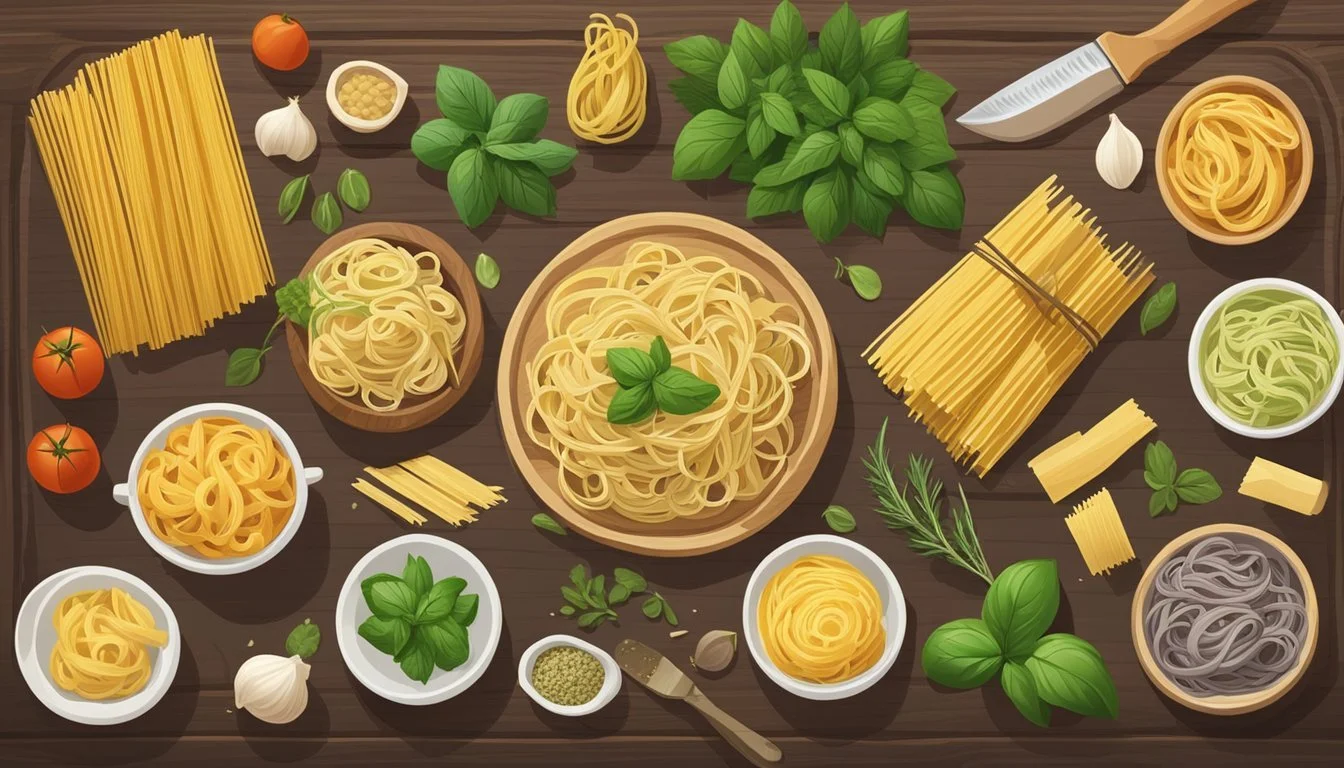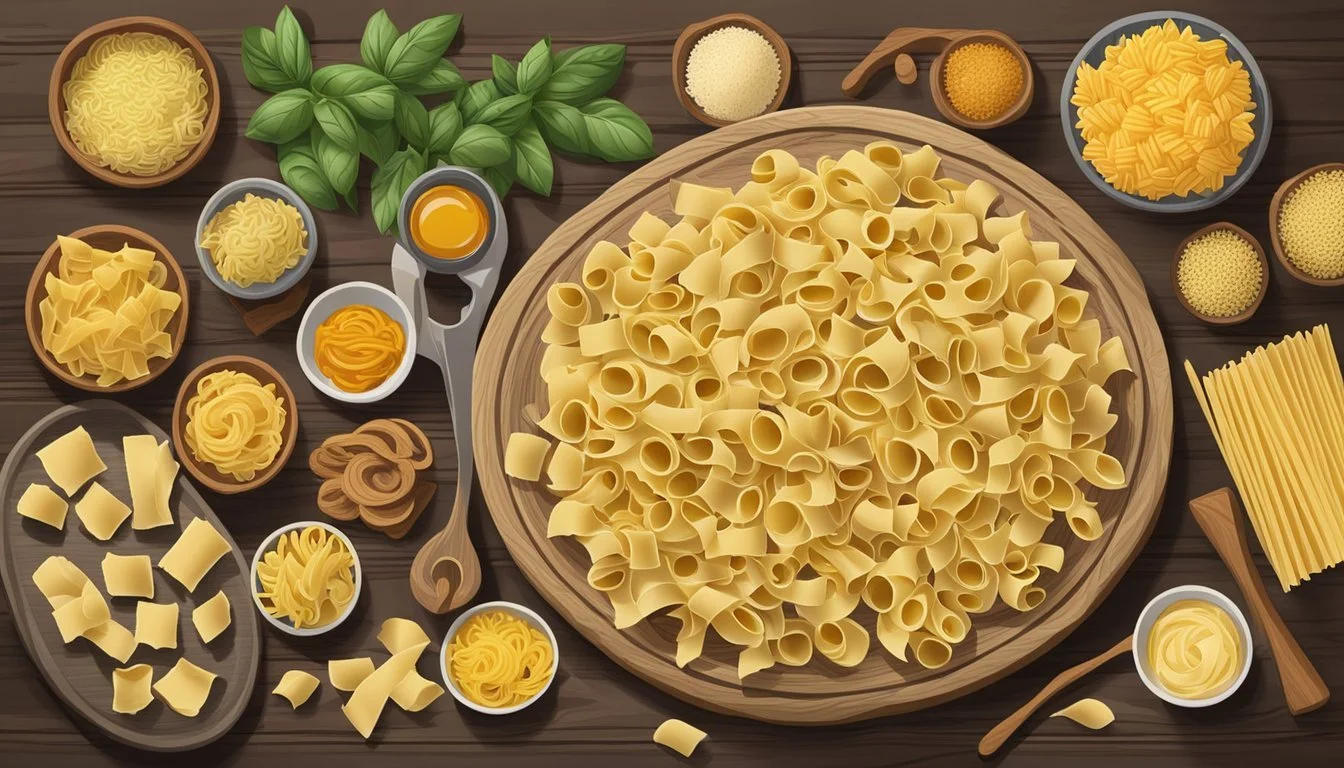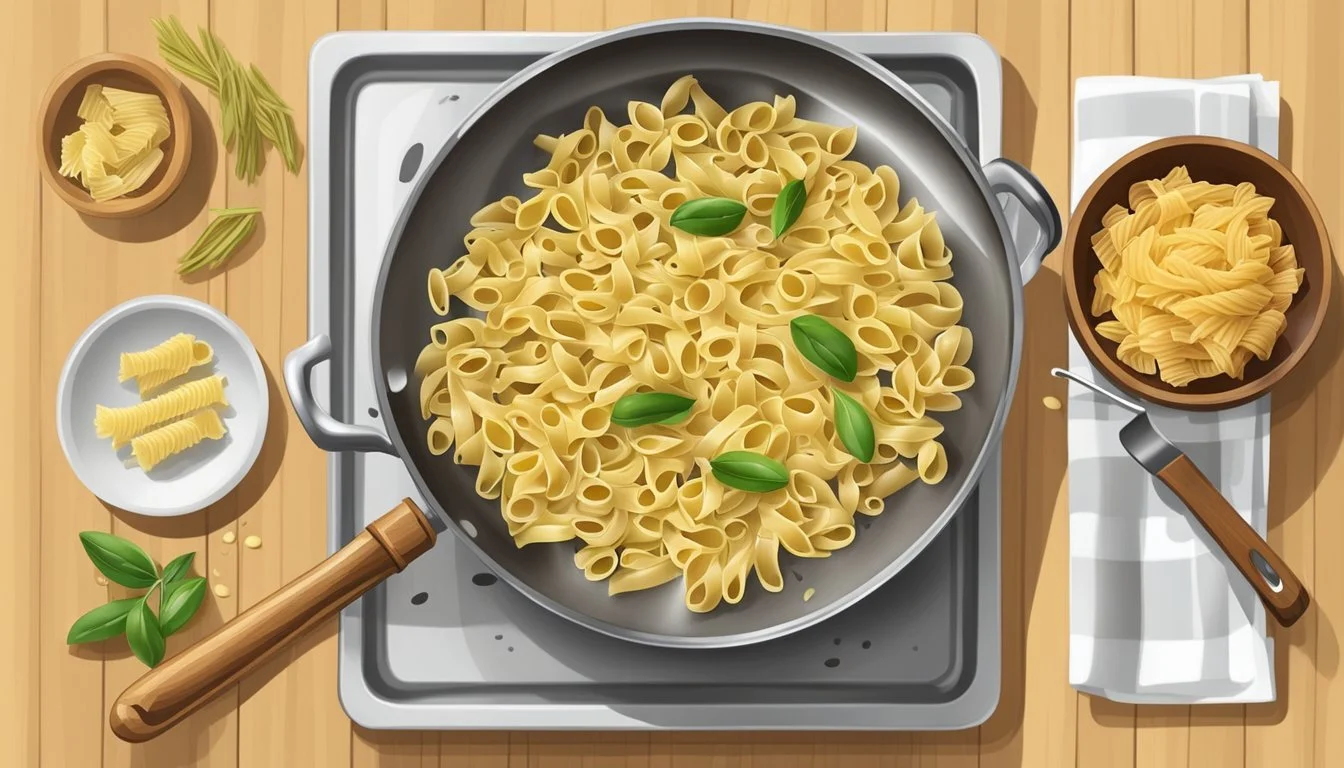Chitarra Pasta Substitutes
Top Alternatives for Traditional Italian Dishes
Chitarra pasta (What wine goes well with pasta?), a traditional Italian pasta named after the guitar-like instrument used to cut it, is a staple in the region of Abruzzo, Italy. Its distinctive texture and shape are achieved through this unique cutting process, which creates strands that are square in cross-section rather than round. This gives the chitarra pasta a more rustic feel and enables it to hold on to sauces with tenacity.
For those seeking alternatives to chitarra pasta, either due to dietary restrictions or simply a desire to experiment with different textures and flavors, there are numerous options available. Substitutes such as spaghetti or linguine can offer a similar mouthfeel and can be used interchangeably in most recipes calling for chitarra. Those looking for gluten-free or lower-carb options might consider rice noodles, brown rice pasta, or even vegetable-based noodles like zucchini spirals.
The decision to replace chitarra pasta with another variety depends on personal preferences and the specific requirements of the recipe. Each substitute brings its own characteristics to the dish, so choosing the right alternative can preserve or even enhance the culinary experience. When switching out chitarra for another type of pasta or noodle, the cook may need to adjust cooking times and consider how the texture will interact with the sauce and other ingredients.
Understanding Chitarra Pasta
Chitarra pasta is a distinctive Italian pasta with its roots in tradition and a unique method of preparation that involves using a tool called "la chitarra" to create its shape.
History and Tradition
The name "chitarra" translates to "guitar" in Italian, a name derived from the traditional instrument used in the pasta's creation. This tool consists of a wooden frame strung with wires, similar to the strings of a guitar. Originating from the Abruzzo region of Italy, chitarra pasta is a testament to the ingenuity of Italian pasta makers dating back to the 18th century, particularly notable in the province of Chieti.
First known use: Chitarra pasta saw its advent in the 1700s.
Region: Abruzzo, Italy.
The Making of Chitarra Pasta
To make chitarra pasta, one must prepare a dough, typically consisting of semolina flour, water, and eggs. The dough is then kneaded until it achieves the right consistency and elasticity.
Dough preparation: Combine semolina flour and eggs.
Kneading: Work the dough until smooth.
Shaping: Roll the dough out into sheets.
Next, each sheet of dough is laid atop the strings of the chitarra. A rolling pin is used to press and roll over the dough, cutting it into strands with the instrument's wires. The result is a pasta with square edges, unlike the round edges of traditional spaghetti.
Tool: La Chitarra.
Technique: Pressing dough into wires using a rolling pin.
Texture: Square-edged pasta strands.
This method imparts the pasta with a texture that holds sauces remarkably well, making it a cherished part of Italian culinary tradition.
The Importance of Ingredients
The selection and quality of ingredients are pivotal in crafting a high-quality Chitarra pasta dish. Each component plays a unique role in texture, flavor, and the pasta's overall structure.
Choosing the Right Flour
For a genuine Chitarra pasta, semolina flour is the cornerstone. This coarse, purified wheat middling of durum wheat is prized for its high gluten content, which lends the pasta a desirable firm texture and a good bite after cooking. While all-purpose flour can be used, the authentic texture and flavor are best achieved with semolina.
The Role of Eggs in Pasta Dough
Eggs are essential for their binding properties in the pasta dough. They provide structure and richness and help to create a malleable dough that can withstand the pressure of being cut on a Chitarra. The number of eggs, the size, and their freshness impact the dough's elasticity and final taste.
Salt and Olive Oil Additions
Salt is integral, not only for flavor but also for strengthening the gluten network in the pasta. A rule of thumb is to add salt to the boiling water until it's as salty as the ocean. Meanwhile, a drizzle of extra virgin olive oil in the dough can enhance the flavor and texture, making it slightly more tender, though traditional Chitarra pasta may not always include it.
Chitarra Pasta Substitutes
Chitarra pasta, known for its square-shaped strands, is a traditional Italian pasta but may not meet everyone's dietary needs or preferences. This section explores suitable substitutes that cater to gluten-free, low-carb, and vegetable-based diets, without compromising on taste.
Gluten-Free Alternatives
Rice Noodles: A popular gluten-free option, rice noodles offer a similar texture to chitarra pasta and are versatile for various dishes.
Brown Rice Pasta: For a whole-grain, fiber-rich alternative, brown rice pasta provides a nutty flavor and firmer bite.
Low Carb and High Protein Options
Shirataki Noodles: Made from the konjac yam, shirataki noodles are high in fiber and low in carbohydrates, ideal for those on a keto diet or managing diabetes.
Kelp Noodles: Sea kelp is turned into translucent noodles that are low in calories and carbohydrates while providing a mineral-rich choice for pasta lovers.
Vegetable-Based Varieties
For a nutrient-dense substitute, vegetables offer a way to enjoy a pasta-like experience with additional health benefits.
Zucchini Noodles (Zoodles): They mimic the shape of pasta and are a light, hydrating option with a dose of vitamins.
Spaghetti Squash: Once cooked, the flesh of this squash pulls apart in strands similar to spaghetti, providing a low-calorie and fiber-rich pasta alternative.
Butternut Squash: Its sweet, nutty flavor can enhance dishes with a pasta-like texture when sliced thinly or spiraled.
Cooking and Serving Techniques
When cooking and serving Chitarra pasta, achieving the desired texture, pairing with the right sauce, and knowing how to preserve and reheat are critical for the best culinary experience.
Achieving Al Dente Texture
One aims to cook Chitarra pasta to al dente, which means the pasta is cooked to be firm to the bite. The precise cooking time can vary, but a general guideline is to boil the pasta for about 4 to 5 minutes. It's essential to stir occasionally to prevent sticking and ensure even cooking.
Steps for Al Dente Chitarra pasta:
Bring a large pot of salted water to a rolling boil.
Add pasta and cook for 4 to 5 minutes, stirring occasionally.
Taste a strand of pasta to check for a firm, yet tender texture.
Drain pasta and rinse with warm water to stop the cooking process.
Sauce Pairing and Garnishing
Chitarra pasta's robust texture pairs well with both light and hearty sauces. For a simple yet flavorful option, toss the pasta with melted butter and a bit of garlic. Alternatively, a richer companion would be a meat-based sauce that clings to the strands.
Sauce Suggestions:
Garlic and Butter: Melt butter with minced garlic and toss with pasta.
Hearty Meat Sauce: Coat the pasta in a thick sauce, ensuring each strand is well dressed.
Finish the dish with a generous sprinkle of pecorino romano cheese or Parmigiano-Reggiano for added sharpness and flavor depth. Garnishes such as fresh herbs can also enhance the visual appeal and taste.
Preserving and Reheating Pasta
Chitarra pasta retains its quality when stored properly. To preserve pasta for later use, ensure it is cooled completely before sealing it in an airtight container.
Preservation Tips:
Refrigerator: Store in the refrigerator for up to 3-5 days.
Freezer: To freeze, lay pasta flat on a baking sheet until solid, then transfer to a freezer bag. It can last up to 3 months.
To reheat, one can either warm the pasta in boiling water for about 30 seconds or sauté it briefly in a pan with a bit of oil or butter, reviving its lush texture and warmth.
Alternative Cooking Methods
When making chitarra pasta, one does not necessarily need the traditional chitarra pasta cutter. There are efficient alternatives that can produce similar results. Below are methods that utilize common kitchen tools to recreate the unique texture and shape of chitarra pasta at home.
Using a Pasta Machine
A pasta machine can serve as a practical alternative to a chitarra cutter. To mimic the chitarra's distinctive strands:
Prepare the pasta dough as usual, ensuring it holds together well for cranking through a machine.
Flatten the dough into sheets using the pasta machine's rolling setting.
Employ the spaghetti or linguine cutting attachment to slice the sheets into strands.
Care must be taken to achieve the desired thickness of chitarra noodles, typically about 2-3mm. This method imparts a uniform cut to the pasta, ensuring consistent cooking times and texture.
Hand Rolling and Cutting Techniques
For those who prefer a homemade touch or lack a machine, hand rolling and cutting techniques are a viable choice.
Begin by rolling out the pasta dough evenly with a rolling pin, aiming for a thickness equivalent to that produced by a chitarra.
With a sharp knife or a pastry wheel, cut the dough manually into long, even strands.
It may take practice to master the thickness and uniformity of the strands. However, this method allows for personalized adjustments to the noodle size catering to one's preferences. Each strand reflects the care put into the manual process, often revealing a rustic and artisanal quality to the meal.
Health Considerations
When considering healthful alternatives to chitarra pasta, one needs to assess the caloric and nutritional information alongside selecting options that align with specific dietary needs.
Caloric and Nutritional Information
Chitarra pasta, like most traditional pastas, is primarily composed of carbohydrates with moderate protein content. Alternatives such as quinoa pasta offer a higher protein and fiber content, while options like zucchini noodles can significantly reduce calorie intake. Here's a comparison in terms of calories, fiber, and protein content.
Pasta Alternative Approx. Calories (per 100g) Fiber (g) Protein (g) Quinoa Pasta 370 5 14 Zucchini Noodles 20 1.2 1.5 Brown Rice Pasta 350 2 6 Spiralized Vegetables Varies (low caloric value) Varies Varies
Diet-friendly Pasta Options
Dietary considerations bring various pasta alternatives into focus. Gluten-free options are widely sought after and include brown rice pasta and quinoa pasta—both derived from naturally gluten-free grains. For those monitoring their carbohydrate intake, vegetable-based noodles from spinach, eggplant, beets, or broccoli provide a nutritious substitute with lower carbohydrates. Here's a quick list showcasing their benefits:
Spinach Noodles: High in vitamins and minerals, low in carbohydrates.
Eggplant Noodles: Low in calories and carbohydrates, offers fiber.
Beet Noodles: Contain nitrate, fiber, and vitamin C.
Broccoli Noodles: Rich in vitamin C and K, and fiber, while remaining low in calories.
Storing Homemade Pasta
Proper storage of homemade pasta is essential to maintain freshness and texture. Whether one chooses to refrigerate or freeze their pasta, there are specific techniques that ensure the pasta's quality is preserved until it's ready to be cooked.
Refrigeration Best Practices
When refrigerating homemade pasta dough, one should wrap it tightly in plastic wrap to prevent air exposure. If dealing with shaped pasta, it's advised to place it in a single layer on a tray or a plate before covering. Pasta should also be dusted with flour to prevent sticking. In the refrigerator, fresh pasta can last for up to 2 days.
Plastic Wrap: Tightly seal pasta dough or shaped pasta to minimize air contact.
Flour Dusting: Lightly coat pasta with flour to prevent sticking together.
Freezing and Thawing Techniques
Freezing pasta is an excellent option for long-term storage. To freeze pasta, one should first lay it out on a baking sheet in a single layer until frozen. Afterward, transfer the pasta into airtight freezer bags, removing as much air as possible before sealing. Pasta can be stored in the freezer for up to 3 months.
Thawing should be done by transferring the pasta from the freezer to the refrigerator several hours before use. Alternatively, for quick cooking, frozen pasta can go directly from the freezer into boiling water using a colander for ease of handling.
Airtight Freezing: Store in freezer bags and label with the freezing date.
Thawing Methods: Refrigerate to thaw gradually or cook directly from frozen.








